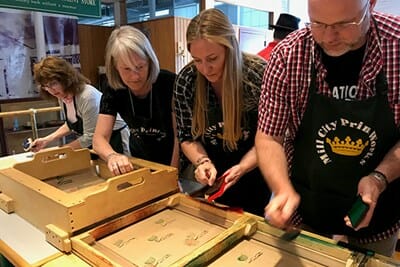Teachers Learn Hands-on American History in Lowell
College of Education Runs NEH-Funded Seminars With Lowell National Historical Park
Source: uml.edu
Photo by Sheila Kirschbaum
Photo Caption: High school social studies teacher Jeff White, right, “works the line” printing tea towels at the Tsongas Industrial History Center as part of a National Endowment for the Humanities summer teacher institute.
By Katharine Webster
Photo by Sheila Kirschbaum
Teachers weave cloth on manual looms at the Tsongas Industrial History Center.
Now, when White teaches American history, he will bring photos and stories from his week in Lowell and a more nuanced understanding of industrial technology and social history to his students, he says. They already read Upton Sinclair’s “The Jungle,” which portrays the terrible conditions for immigrants working in Chicago’s stockyards and meatpacking plants in the early 1900s. Now he will also assign Katherine Paterson’s “Lyddie,” about a farm girl who comes to work in the Lowell textile mills in the early 1800s.
Photo by K. Webster
Historians Gray Fitzsimons, left, and David McKean lead the teachers on a walking tour about immigration in Lowell’s Acre neighborhood.
The program was created by the Tsongas Industrial History Center, an education partnership between UMass Lowell’s College of Education and the Lowell National Historical Park that also hosts about 45,000 schoolchildren each year through field trips.

Photo by Sheila Kirschbaum
Teachers assemble ballpoint pens — a lesson they can do with their students — as History Prof. Robert Forrant looks on.
While the program is based in Lowell, the teachers travel to the birthplace of Transcendentalism in Concord and visit Old Sturbridge Village in central Massachusetts to understand rural life at the time industrialization began in earnest.
Photo by Sheila Kirschbaum
Teachers make a meal from scratch and cook on a hearth at Old Sturbridge Village.
They card and spin wool and weave a small square of cotton fabric on a manual loom – and compare that to the speed and clatter of production in the textile mills. They learn how to build canal systems and test the efficiency of waterwheels, and they talk about “green” engineering and the ecological costs of diverting river water.
This program is very well-constructed,” says Paul Horton, a high school history teacher at the University of Chicago Laboratory Schools. “It’s a very intentional balance of content and experience – the hands-on stuff you get at the museums, the walking tours and the living history at Old Sturbridge Village.”
Photo by Sheila Kirschbaum
Megan Wong Regalada, a second-grade teacher from Seattle, pets a calf at Old Sturbridge Village.
Amber Robins, an English teacher at Roxana High School in the St. Louis metropolitan area, was fired up by Assoc. Prof. of English Bridget Marshall’s lecture on writings by the mill girls in “The Lowell Offering,” especially the mill girls’ response to the Transcendentalists’ critique of industrialization.





